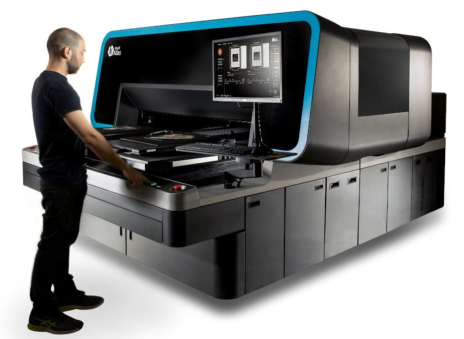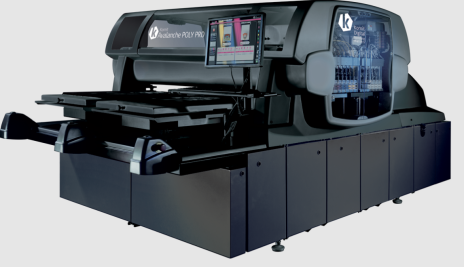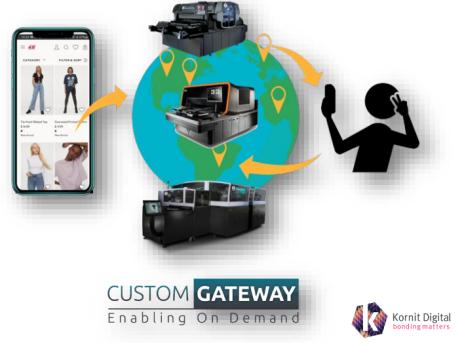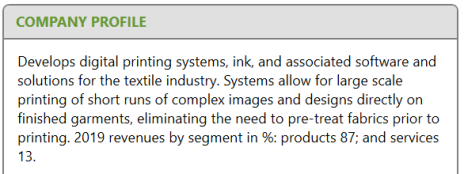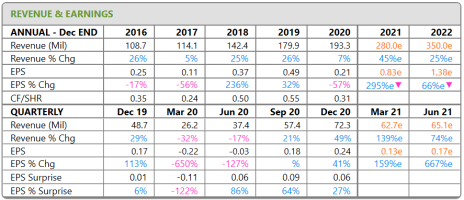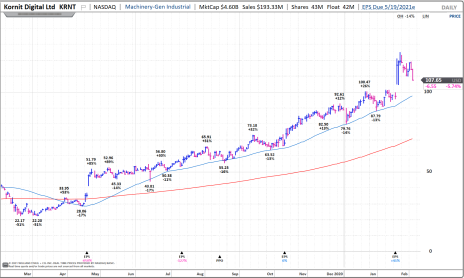As we march toward spring it appears real-world risks are decreasing (more vaccines, lower case count, etc.) while the market risk for growth stocks has gone up (higher yields, volatility, etc.), at least in the short term.
As I scanned through dozens of charts and evaluated stories for this month’s addition my focus was repeatedly drawn to one stock. The chart is compelling, the story is enticing, and the recent Q4 report and forward guidance illustrate sound fundamentals, supported by long-term demand growth.
The stock appropriately balances the potential risks and rewards in the current market.
Enjoy!
Cabot Small Cap Confidential 262
[premium_html_toc post_id="226560"]
The Big Idea
One of the unsung heroes of the online retail boom is a largely unknown technology – digital printing on fabrics and textiles.
While many traditional manufacturers and retailers of clothes, fashion items and home décor were destroyed during the pandemic, the inverse was true for those that had online marketplaces supported by digital printing and on-demand manufacturing.
These sellers, and the brands they represent, picked up the baton and fulfilled orders that flowed in at a torrid pace.
Whereas older methods of designing and printing garments and fabrics often mean working with toxic chemicals, building inventory, and hoping to sell whatever is produced, digital printing offers a completely new way to fill orders that better matches production with the way ecommerce and online markets work today.
Digital printing allows for short production runs, custom work (even one-offs), quick turnaround time, environmentally friendly inks, and printing on a wide variety of textiles and fabrics.
Soon, layered printing that closely resembles embroidery will be possible.
These attributes are a perfect match for many of today’s designers and manufacturers of clothes, furniture coverings, home décor items (rugs, drapes, etc.) and athletic apparel.
It’s not a stretch to say that digital printing is the very reason many of these businesses have come to be in the first place.
Many of these players produce only what they can sell based on current demand trends, manufacture close to where their customers are, and deliver quickly. Sometimes, they create and produce items based on what’s trending on social media. They have little to no appetite for inventory risk.
The pandemic has been a tailwind. It catapulted digital printing to the front of the line as a must-have technology for many fashion, clothing and home décor businesses. As the installed base of printers has swelled so too has sales volume for inks and use of specialized software that helps turn online orders into printed products.
Digital garment and textile printing is one of the unseen structural shifts occurring in the clothing, athletic and home décor markets. I don’t think it’s going to end or slow down as economies open. And we have just the stock to play the trend.
The Company
Kornit Digital (KRNT) designs and manufactures industrial digital printing technologies for the garment, apparel, and home goods markets. It represents a way to play mass-market adoption of digitally printed textiles on a huge range of items, including clothes, sheets, furniture coverings, rugs, curtains, rolled fabric and more. The company has a market cap of $4.7 billion.
Digital printing on textiles was taking off before the pandemic. The drivers have been online shopping and ecommerce, shorter/flexible production runs, custom work, demand for environmentally friendly products and a trend of companies putting production closer to end-customers.
There is no doubt the pandemic has accelerated adoption. Clients that started with digital printing a year or two ago are ramping up production and buying more printers and more advanced models. That means more ink and software too.
The pitch is straightforward. The technology allows for short runs and just-in-time manufacturing, which translates into shorter time to market (days, not months) and less inventory risk. Companies have more control over their operations and supply chains can better adapt to shifting market demands. Printing textiles is also more environmentally friendly than dyeing.
Kornit Digital has been one of the big innovators in the market. The Israel-based company was founded in 2002 and now has over 500 employees and five regional offices (New Jersey, Miami, Hong Kong, Shanghai and Dusseldorf) that handle sales, marketing, logistics and customer support. All printer R&D and manufacturing is done in Israel.
The company is a one stop shop for customers, selling an integrated product suite of direct-to-garment (DTG) printers, direct-to-fabric (DTF) printers, software, inks and consumables, pallets and accessories, technical support and services.
Altogether, Kornit has over 1,400 customers spanning custom decorators, fulfillment centers and vertically integrated companies. Spreadshirt is a customer. Adidas is another. Printful, Spoonflower, Fanatics and Next are customers as well.
One digital fulfillment client is Creazioni Digitali, which serves many fashion brands, including Versace.
Another client is Amazon, which uses Kornit’s equipment in the Merch by Amazon program. This is a self-service platform that lets creators design tee-shirts that consumers can order. Kornit also has a strategic relationship with Amazon, which purchased warrants in the company. This relationship means Amazon is incentivized to see Kornit succeed.
Products & Platform
Kornit sells high definition direct-to-garment printers (DTG), direct-to-fabric printers (DTF), inks, consumables, and software.
The digital printing process involves specially engineered inkjet heads that print images and designs directly on garments and fabrics, which are fed into a machine one at a time and held in place by specialized pallets or on rolls.
The technology eliminates many of the complicated, time consuming, toxic and expensive steps required of other production methods (like screen printing), such as screen prep, cylinder engraving, preparing pastes and inks, alignment, and more.
HD Direct-To-Garment (DTG) Technology
In DTG printing an inkjet printer prints directly on the item. This can be done on fabrics that have already been sewn and dyed, such as t-shirts. Kornit’s technology uses a patented wet-on-wet printing method that eliminates the practice of coating and dyeing prior to printing. The technology allows printing on a variety of untreated natural, synthetic and man-made fabrics, including cotton, wool, polyester, lycra and denim.
Depending on the system, Kornit’s printers can do 32 to 235 garments per hour. This means the company can supply both entry-level customers up to mass producers.
Here are a few notes on the latest printers in Kornit’s DTG product line.
Atlas: An industrial DTG printer for high volume production. It can do 160 items in an hour, including printing on dark garments. Operators can replace pallets depending on what type of items is being printed. Atlas is roughly the size of a car and would be a likely choice for high volume tee shirt printing. Annual output is 420,000 to 640,000 units.
Avalanche HD6: An industrial HD printer that uses less ink than other models and allows for a more supple feeling end-product. Often used for cost-efficient production that’s comparable in cost to (or lower than) screen printing for under 500 units and/or one-off printing projects. Can print white. Output ranges from 237,000 to 360,000 a year.
Storm HD6: A commercial DTG printer for small to mid-sized businesses in a slightly smaller form factor than Avalanche HD6. Depending on configuration output is 50,000 to 165,000 units.
Vulcan Plus: A large printer for both one-offs and long runs (620,000 to 940,000 units a year) that blends low ink consumption, mass customization, supple end products and web-to-print potential. It is for customers that do enough volume of retail quality products to warrant the investment.
Avalanche Poly Pro: Specifically designed for polyester printing the Avalanche Poly Pro is for customized polyester products (including poly blends) with no minimum order quantity. This printer has made it possible for all variety of athletic garments to be created and made in whatever quantities customers want. A true game changer.
Direct-To-Fabric (DTF) Technology
DTF printing technology allows for printing on fabrics that eventually become finished garments, furniture coverings, rugs and other home and office décor items. Like Kornit’s DTG printers its DTF technology uses the company’s proprietary wet-on-wet printing method. It also employs and integrated curing system so workers don’t have to deal with huge rolls of wet fabric.
These printers are targeted at three types of businesses: (1) those that are expanding into fabric decoration and which likely require some combination of customization and quantity flexibility to meet incoming online demand, (2) fabric converters, which source a lot of untreated fabric and covert it into finished material to sell to garment and home décor manufacturers, and (3) fashion designers/producers who seek on-demand flexibility and customization.
Kornit says demand for DTF printing is huge. The technology is changing the fashion industry as inquiries and orders from manufacturers of top fashion brands pour in.
Kornit currently offers one DTF printer.
Presto: The Presto replaced its predecessor (Allergro) in mid-2019 and has been a game changer for customers that need to quickly print fabric rolls. It prints, softens and dries in one step. Presto integrates with web-to-print platforms, uses one ink set for all fabrics and eliminates the need for pre-treatment, steaming and washing. This technology is unique in the market and allows for on-demand onshore production. It’s a huge deal in the fashion and home décor markets.
Ink & Consumables
Kornit’s printers use a variety of water-based inks that are printer-specific and trademarked under the brand name NeoPigment. They are non-hazardous and non-toxic and have been specially formulated to overcome the quality-related challenges that pigment-based inks have traditionally faced when used in digital printing.
Software & Services
Kornit sells a variety of software solutions that allows customers to monitor production, analyze how systems are performing and eliminate headaches. The company made a significant acquisition, purchasing Custom Gateway in 2020. This software helps brands, retailers and fulfillers digitize their front ends (sales and catalogs) and match up production with raw material inventory availability and incoming order flow.
The company also manufacturers a range of printing pallets that are garment specific (i.e. for tee shirts, zipper hoodies, shirts with buttons, kid-sized clothes, tote bags, etc.). Finally, Kornit offers a multi-year service contract with each system sold.
Growth Initiatives
Ecommerce a Major Demand Driver: On the Q4 conference call management talked about the continuing shift in the textiles industry to digital printing and how 2020 marked a massive increase in demand from ecommerce owing to the pandemic. This trend is seen snowballing in the coming years.
Cloud Software & On-Demand Printing: Kornit is seeing demand grow for its cloud-based software, which, among other things, helps with on-demand production and inventory management. I expect we’ll see more innovation and acquisitions around software in the coming quarters as Kornit builds out a more integrated product offering.
New Printing & Automation Technologies: Kornit has plans to bring simulated embroidery, high-density printing and vinyl heat transfer effects to market. These are significant innovations and management expects they could support up to a 30% increase in its addressable market. We should hear more in April. Also, in mid-2020 expect to hear about automation solutions that can increase throughput by roughly 20% and reduce manual labor.
Grow Installed Printer Base With Current Customers: As customers scale up their operations they require more printers, different types of printers, and more consumables. There has been a consistent upward trend of customers adding more systems and we expect this trend will continue. On the Q4 call management talked about customers that started with entry-level Kornit systems a year or two ago already upgrading to high-throughput systems now.
The Business Model
Kornit is an industrial printer company and makes money by selling printers, consumables, software and support services. As of the beginning of 2020 every machine sold comes with a multi-year support contract. Ink and other consumables and services tend to carry higher profit margins.
Prices for Kornit’s printers range from $70,000 to over $800,000. They consume anywhere from $5,000 to $300,000 of ink and consumables a year. Altogether, sales of products (printers, inks, consumables, etc.) generated 85% of 2020 revenue while sales of services generate the other 15%.
The bulk of revenue comes from the Americas (75%) while 20% comes from EMEA and 5% from APAC. The biggest 10 customers generate roughly 60% of revenue.
Kornit uses a mix of direct and indirect sales teams as well as a network of independent distributors and value-added resellers. It has begun to focus more on a direct sales model, especially since early 2019, when management ended its relationship with a North American distributor.
The Bottom Line
In 2019 revenue rose by 26% to $180 million. The first half of 2020 was dramatically impacted by Covid-19 related shutdowns. Revenue fell by 32% in Q1 and 17% in Q2.
However, business has rebounded sharply since. Revenue in Q3 grew 21% to $57.4 million and Q4 revenue (reported on February 16) was up 49% to $72.3 million. That result smashed analyst expectations by $10.5 million (17%). Moreover, Q4 adjusted EPS of $0.24 beat by $0.02 as high-margin consumables, services and high-end systems drove margin expansion.
All in, 2020 revenue was up just 7% to $193.3 million while adjusted EPS of $0.21 fell by 57%. Results in the second half illustrate a dramatic rebound and accelerating business.
Management guided for Q1 2021 revenue of $61 million to $65 million (up 140% at the midpoint). For the full year 2021 analysts see revenue growing by 45% to $280 million while adjusted EPS could surge 295% to $0.83. Revenue is seen rising another 25% in 2022. Kornit ended fiscal 2020 with $436 million in cash and equivalents.
Risk
Reliance On a Few Customers: Ten customers generated 62% of revenue in Q4 2020 and one customer (not Amazon) generated more than 10%.
Covid-19: Covie-19 still has the potential to disrupt businesses in 2021, however given what we know now the risk appears to be quite manageable.
Seasonality: Business is strongest in Q4 then Q1 is the slowest and business builds throughout the year. Given the huge Q4 2020, and likely spillover into Q1, investors are understandably excited about a big Q1 as well (especially relative to a horrible one in 2020). It is important that Kornit meets or exceeds Q1 expectations and guides for a strong 2021.
Move to Direct Sales Force: A move toward a direct sales strategy requires hiring and managing salespeople and carries both benefits and risks.
Agreement With Amazon: In May 2016 Kornit entered into an agreement with Amazon to supply systems and ink for its Merch by Amazon program. The deal included a scaled investment (through warrants) by Amazon and had a five-year term, extended automatically each year provided certain conditions are met. May 2021 marks the end of that agreement unless it is extended. While Kornit’s business is more diversified now than in 2016 there is some risk around this agreement and investor reaction to whatever happens.
Supply Chain Risk: Kornit’s printers require specialized components and any shortages could impact their ability to fulfill orders.
Competition
Kornit faces competition from manufacturers of analog screen-printing systems, textile printers and ink, industrial digital DTG and DTF players. Some of these companies include M&R Printing Equipment, Machines Highest Mechatronic, Aeoon Technologies, Brother International Corp., Seiko Epson, Ricoh, The Dream Junction/OvalJet, Dover Corporation, Electronics for Imaging, Fratelli Robustelli and Durst Phototechnik.
The Stock
Trading Volume: KRNT trades an average of 238,000 shares daily. Heavy days are 500,000 or more and there have been eight of those over the last six months (seven up days, one down), three of which came right after Q4 earnings were released.
Historical Price: KRNT went public at 10 in early 2015 but didn’t really gain momentum until 2019. Shares hit an all-time high of 45 just before the pandemic, then got cut in half during the market crash. KRNT roared back and made a new all-time high in late-May after Q1 2020 earnings were released, then walked steadily higher making a series of higher highs and higher lows. Pullbacks have been in the -11% to -17% range. The stock peaked near 100 in February then jumped to 117 after the Q4 report on 2/17. KRNT has been trading in the 109 to 120 range in the two weeks since reporting.
Valuation & Projected Price Target: KRNT trades at an EV/2021E revenue multiple of 17. Consensus estimates call for 45% revenue growth, to $280 million, this year. Applying a multiple of 23 on the stock implies 40% upside, to around 150. I think that’s a fair starting point for now. As we move through 2021 we’ll gain a better feel for the revenue trajectory, which I expect will exceed estimates and warrant a higher multiple and share price.
Buy Range: In the near term expect to buy in the 105 to 120 range. If KRNT goes below the lower end of the post-earnings gap at 105, then trends below 100, we’ll evaluate if it’s still a buy or a hold as market conditions and any new news would need to be factored in.
The Next Event: Management should update investors on new products in April then report Q1 2021 results sometime in May.
Updates on Current Recommendations
| Stock Name | Date Bought | Price Bought | Price on 3/3/21 | Profit | Rating |
| Accolade (ACCD) | 8/6/20 | 40.09 | 44.21 | 10% | Buy |
| Arena Pharmaceuticals (ARNA) | 2/2/18 | 38.93 | 73.26 | 88% | Buy |
| Avalara (AVLR) | 2/1/19 | 40.05 | 147.39 | 268% | Hold |
| BioLife Solutions (BLFS) | 11/5/20 | 32.5 | 37.85 | 16% | Buy |
| Cardlytics Inc (CDLX) | 9/6/19 | 37.97 | 125.01 | 229% | Hold |
| Cerence (CRNC) | 10/1/20 | 49.83 | 103.06 | 107% | Buy |
| Everbridge (EVBG) | 12/2/16 | 15.51 | 146.72 | 846% | Buy |
| Fiverr Intl (FVRR) | 3/5/20 | 32.32 | 242.99 | 652% | Hold 1/2 |
| Goosehead Insurance (GSHD) | 9/7/18 | 31.35 | 125.49 | 300% | Hold 1/2 |
| Inspire Medical (INSP) | 10/4/19 | 58.54 | 231.53 | 296% | Hold |
| Personalis (PSNL) | 12/3/20 | 28.29 | 27.97 | ---- | SOLD |
| Porch Group (PRCH) | 1/7/21 | 13.19 | 17.99 | 36% | Buy |
| Profound Medical (PROF) | 2/4/21 | 26.74 | 21.77 | -19% | Buy |
| Q2 Holdings (QTWO) | 4/1/16 | 23.81 | 113.78 | 378% | Hold |
| Repligen (RGEN) | 11/2/18 and 12/31/18 | 59.19 | 199.55 | 237% | Buy |
| Sprout Social (SPT) | 9/3/20 | 36.48 | 58.08 | 59% | Hold |
Please email me at tyler@cabotwealth.com with any questions or comments about any of our stocks, or anything else on your mind.
Glossary
Buy means accumulate shares at or around the current price.
Hold means just that; hold what you have. Don’t buy, or sell, shares.
Sell means the original reasons for buying the stock no longer apply, and I recommend exiting the position.
Sell a Half means it’s time to take partial profits. Sell half (or whatever portion feels right to you) to lock in a gain, and hold on to the rest until another ratings change is issued.
The next Cabot Small-Cap Confidential issue is scheduled for April 1, 2021.
Cabot Wealth Network
Publishing independent investment advice since 1970.
President & CEO: Ed Coburn
Chairman & Chief Investment Strategist: Timothy Lutts
176 North Street, PO Box 2049, Salem, MA 01970 USA
800-326-8826 | support@cabotwealth.com | CabotWealth.com
Copyright © 2021. All rights reserved. Copying or electronic transmission of this information is a violation of copyright law. For the protection of our subscribers, copyright violations will result in immediate termination of all subscriptions without refund. No Conflicts: Cabot Wealth Network exists to serve you, our readers. We derive 100% of our revenue, or close to it, from selling subscriptions to its publications. Neither Cabot Wealth Network nor our employees are compensated in any way by the companies whose stocks we recommend or providers of associated financial services. Disclaimer: Sources of information are believed to be reliable but they are not guaranteed to be complete or error-free. Recommendations, opinions or suggestions are given with the understanding that subscribers acting on information assume all risks involved. Buy/Sell Recommendations: All recommendations are made in regular issues or email alerts or updates and posted on the private subscriber web page. Performance: The performance of this portfolio is determined using the midpoint of the high and low on the day following the recommendation. Cabot’s policy is to sell any stock that shows a loss of 20% in a bull market or 15% in a bear market from the original purchase price, calculated using the current closing price. Subscribers should apply loss limits based on their own personal purchase prices.
